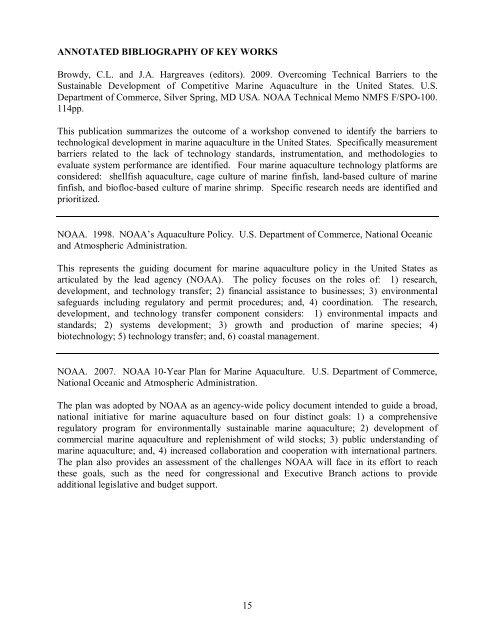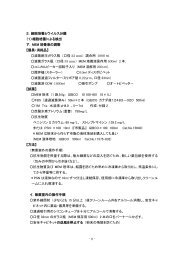Program and Abstracts(PDF)
Program and Abstracts(PDF)
Program and Abstracts(PDF)
You also want an ePaper? Increase the reach of your titles
YUMPU automatically turns print PDFs into web optimized ePapers that Google loves.
ANNOTATED BIBLIOGRAPHY OF KEY WORKS<br />
Browdy, C.L. <strong>and</strong> J.A. Hargreaves (editors). 2009. Overcoming Technical Barriers to the<br />
Sustainable Development of Competitive Marine Aquaculture in the United States. U.S.<br />
Department of Commerce, Silver Spring, MD USA. NOAA Technical Memo NMFS F/SPO-100.<br />
114pp.<br />
This publication summarizes the outcome of a workshop convened to identify the barriers to<br />
technological development in marine aquaculture in the United States. Specifically measurement<br />
barriers related to the lack of technology st<strong>and</strong>ards, instrumentation, <strong>and</strong> methodologies to<br />
evaluate system performance are identified. Four marine aquaculture technology platforms are<br />
considered: shellfish aquaculture, cage culture of marine finfish, l<strong>and</strong>-based culture of marine<br />
finfish, <strong>and</strong> biofloc-based culture of marine shrimp. Specific research needs are identified <strong>and</strong><br />
prioritized.<br />
NOAA. 1998. NOAA’s Aquaculture Policy. U.S. Department of Commerce, National Oceanic<br />
<strong>and</strong> Atmospheric Administration.<br />
This represents the guiding document for marine aquaculture policy in the United States as<br />
articulated by the lead agency (NOAA). The policy focuses on the roles of: 1) research,<br />
development, <strong>and</strong> technology transfer; 2) financial assistance to businesses; 3) environmental<br />
safeguards including regulatory <strong>and</strong> permit procedures; <strong>and</strong>, 4) coordination. The research,<br />
development, <strong>and</strong> technology transfer component considers: 1) environmental impacts <strong>and</strong><br />
st<strong>and</strong>ards; 2) systems development; 3) growth <strong>and</strong> production of marine species; 4)<br />
biotechnology; 5) technology transfer; <strong>and</strong>, 6) coastal management.<br />
NOAA. 2007. NOAA 10-Year Plan for Marine Aquaculture. U.S. Department of Commerce,<br />
National Oceanic <strong>and</strong> Atmospheric Administration.<br />
The plan was adopted by NOAA as an agency-wide policy document intended to guide a broad,<br />
national initiative for marine aquaculture based on four distinct goals: 1) a comprehensive<br />
regulatory program for environmentally sustainable marine aquaculture; 2) development of<br />
commercial marine aquaculture <strong>and</strong> replenishment of wild stocks; 3) public underst<strong>and</strong>ing of<br />
marine aquaculture; <strong>and</strong>, 4) increased collaboration <strong>and</strong> cooperation with international partners.<br />
The plan also provides an assessment of the challenges NOAA will face in its effort to reach<br />
these goals, such as the need for congressional <strong>and</strong> Executive Branch actions to provide<br />
additional legislative <strong>and</strong> budget support.<br />
15



